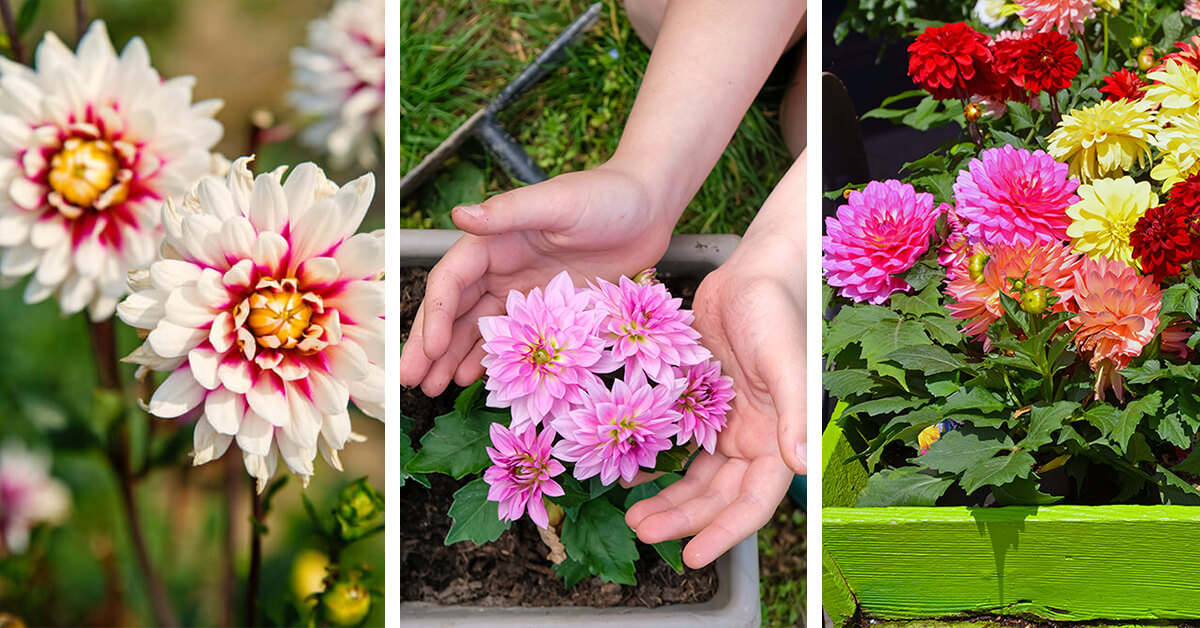Dahlias are members of about 40 species of flowers within the Aster family. Several have been bred for ornamental flowers for use in gardens and floral arrangements. They’re so beautiful you might want to grow Dahlias indoors. But is that possible, and if so, how do you care for them? You can choose from pompoms, waterlilies, peony-flowered, dinner plates, singles, and doubles. Colors include white, red, yellow, and purple. If you’ve got the right soil and sunlight, they’re easy to cultivate, coming into bloom in late summer and staying until the first frost. You’ll find your efforts very satisfying, offering visual pleasure.
Key Takeaways
- Dahlias benefit from full sun, needing 6-8 hours of natural light daily.
- Regular fertilizing and watering as they grow promote a healthy plant.
- You know it’s time to water your potted Dahlias when the soil is mostly dry. Make sure to water at the base of the plant.
- Use a well-drained potting mixture for your Dahlias. The best time to put the tubers in the ground is about 12 weeks after the final frost before spring.
- Use containers that have at least a 3-gallon capacity. For full-size Dahlias, look for a pot 15” wide and 12” deep.
8 Sensible Suggestions for Indoor Dahlias
When to Plant Dahlias
As an indoor gardener, so long as the light, temperature, and humidity are on point, you can actually enjoy growing your Dahlias year round. It’s a little more difficult for those with cold climates because you struggle with shorter days, increased humidity, and temperature variance. If you want to follow their natural cycle, sow them in March or April.
No matter when you choose to grow your Dahlias, you will want to use light-colored pots because darker ones don’t allow light inside. Before you plant your tubers, give them a good soak in lukewarm water for an hour. This rehydrates them.
Plant them with the points up in moist garden soil and house the pot in a location with indirect light until they show signs of growth. Do not water until you see those first sprouts appearing. Then, move the flowers to a spot where they can get 6-8 hours of sunlight a day.
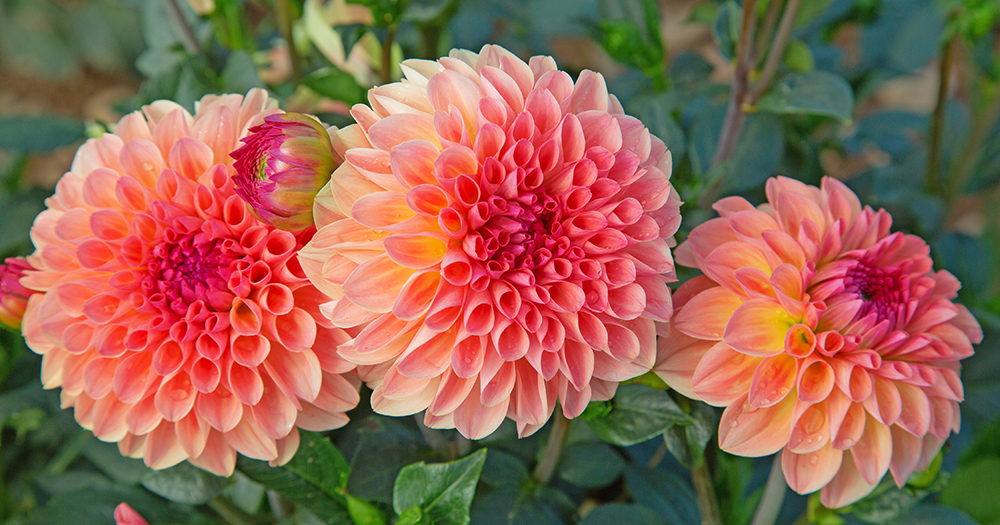
Factoid
Dahlias were initially considered a vegetable. They received their name from a Swedish botanist by the name of Anders Dahl. He considered them a vegetable because the tuber is wholly edible, tasting somewhat like a cross between a radish and a baby potato.
How to Plant Dahlias
The key to planting your Dahlias is using a well-drained potting mixture or garden soil. If the soil is mildly fertilized, you don’t need to add more nutrients. The flower won’t get hungry until they start to grow.
Putting Dahlias in the Soil
If your Dahlia tuber does not have an eye on top, lay them next to each other so they are touching the soil. You do not have to cover them. However, be sure they are not touching each other. This could cause moisture leading to rotting. Large clumps can be managed similarly by spreading them out and putting them in contact with the soil.
Lightly spray the Dahlia tubers daily, but do NOT soak them. Until they reach 2” tall, this is all the water they need.
Dahlia symbolism: in the Victorian Language of Flowers, Dahlia represented eternal commitment and everlasting love. People today still use Dahlias in bridal bouquets for this reason.
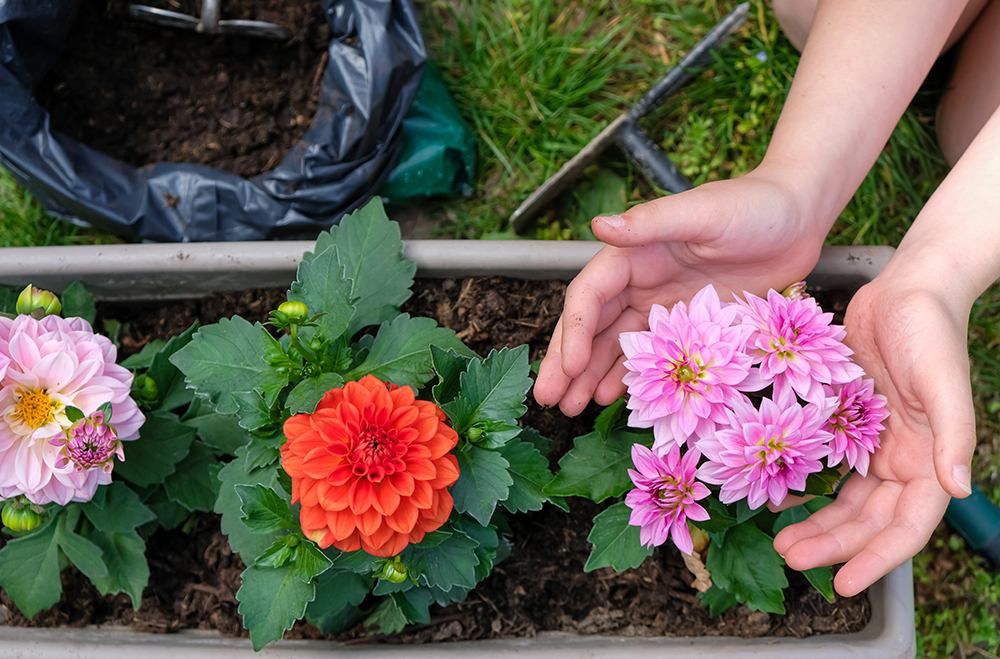
Growing Dahlias in Containers
Dahlias aren’t fussy about their containers except for needing good drainage. For an indoor “garden,” look for pots between 8-10”, with 12” ones if you have long tubers. If you have a collection of crocks lingering in the shed, you can use one, provided you clean it out thoroughly. Not doing so could expose your new plants to lingering diseases or insects.
Location, Location, Location
Unlike some plants, Dahlia tubers should not be placed in the very bottom of the pot underneath the soil. You can rot the tuber by doing so. Instead, begin with soil, place the tuber inside, then cover it lightly. As it grows, add more potting soil to support your flowers.
Soil Options
If you’re not fond of potting mix, Dahlias also appreciate a blend of pet, fine bark, and vermiculite. You can find blends at your garden store. The coarse nature of the soil allows greater airflow and drainage. Never plant your Dahlias in clay-laden soil.
Specifics
If the holes in your container look like they may let soil loose, you can use a coffee filter at the bottom. As an additional benefit, it helps keep bugs out. Now you can fill the flower pot ⅓ full with slightly moist potting soil. Place the tuber’s eye in the middle of the pot. You need at least ¼” space between the pot’s wall and the non-eye part of the tuber. If you already have sprouts, AWESOME. Just place them upward in the soil and let nature do her thing.
Sprinkle lightly-moistened soil over the tuber, but don’t bury it. Fill a spray bottle with luck warm water. Give it a spritz and let things be. At this juncture, you can use growing lights, but honestly, natural light is better. The flowers will be inside your home, so you want them accumulated to the light and heat coming to them from your chosen location.
Turn your pots regularly so the stalks grow straight. Add a bamboo stake for extra support. 4’ is ideal because that’s the average height of Dahlias. Put velcro plant wraps at a couple of spots along the stalk to attach it to the steak. If you like a bushier plant, pinch the tip of the stalk after you have four sets of leaves present.
Watering
During root formation, let the soil become nearly dry before you water it again. If your water is between 6.5-7 pH, it’s ideal. But if the water has sufficient calcium, magnesium, and sulfates, a slightly higher pH won’t bother them much. It is alright if you have a water softener in your home. Dahlias seem to take it in stride.
Temperature
Dahlias can be finicky about temperature. Sudden drops, in particular, can set off their normal growing cycle. For example, perhaps a major rainstorm brings down the temperature from 80 F to 50 F, which can trigger an early shutdown. Now, such weather patterns may not affect the climate in your house, but it’s something to be aware of.
Purposeful Pots
One of the best parts of growing your Dahlias in pots is that you can move them wherever the plant needs them. If they’re growing too tall, take the container to a slightly shadier location, for example. From a decorative standpoint, you can place your Dahlias at the center of your table, on a sideboard or coffee table, or really anywhere that pleases your sensibilities.
Dahlia home sweet home: Mexico named the Dahlia pinnata its national flower. And, rightfully so. The first record of the plant appeared there in 1615. Spanish settlers in Mexico sent some tubers to Europe, and from there, the flower flourished further.
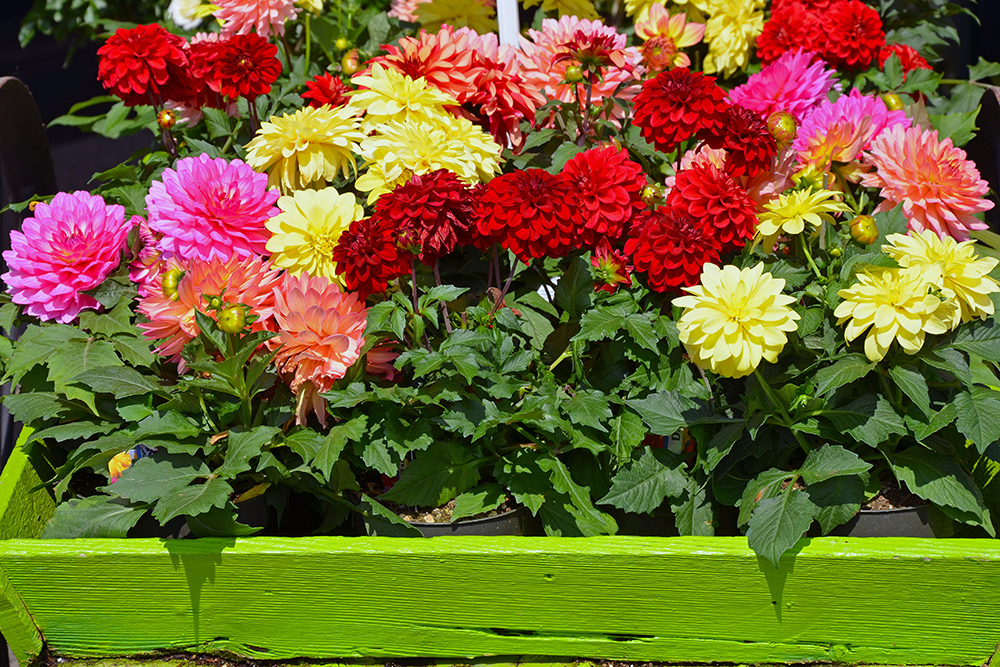
Varieties of Dahlia
Wondering a bit about the different varieties of Dahlias? Let’s take a look:
Anemone Dahlias
Anemone Dahlias are very decorative with a unique texture. Their center looks a bit like a pincushion surrounded by flat petals in a tidy ring. They are about 3-5” across and bring a bit of playfulness to your indoor garden.
Ball Dahlias
Larger than pompom dahlias but also circular. The petals curve in a spiral pattern, so the top is slightly flattened. The giant species produces blossoms 5” or more in diameter. Talk about a WOW factor.
Cactus Dahlias
Cactus Dahlias have double blossoms with dramatic, narrow, pointy petals. The petals curve outward. Size-wise, Cactus Dahlias can grow from medium size to giant, the largest flowers growing to 8” in diameter. These may be too big for indoors, depending on your space constraints.
Decorative Dahlias
Decorative dahlia varieties are perfect for indoors. All in this category have double flowers. The fancier ones have petals growing in a regular pattern. The informal group has wavy petals.
Pompom Dahlias
These flowers really do look like pom poms. The blooms are spherical, the petals curling inward. The pompom dahlias look nearly symmetric in shape. These are generally smaller Dahlias with 2” diameter flowers.
Single Dahlias
True to their name, Single Dahlias have one tidy ring of petals around the center disk (whereas double Dahlias have two). Some have pointed petals, while others are rounded. Pollinators love Single Dahlias.
Waterlily Dahlia
As you’ve probably guessed, these Dahlias look like waterlilies. Their flowers are broad, shallow, and double. They look a bit like a saucer that may be flat or curved. The waterlily dahlia is a lanky plant, sometimes growing to heights of 6 feet, which may be a little large for the home.
There are no blue dahlias: dahlias appear in every color but blue. Breeders have been trying to create one since a London Newspaper offered £1 for someone to do so successfully. Near-blue flowers exist but nothing true blue. Black is similar. Dahlias that look black are actually dark purple.
Dahlia Winter Care
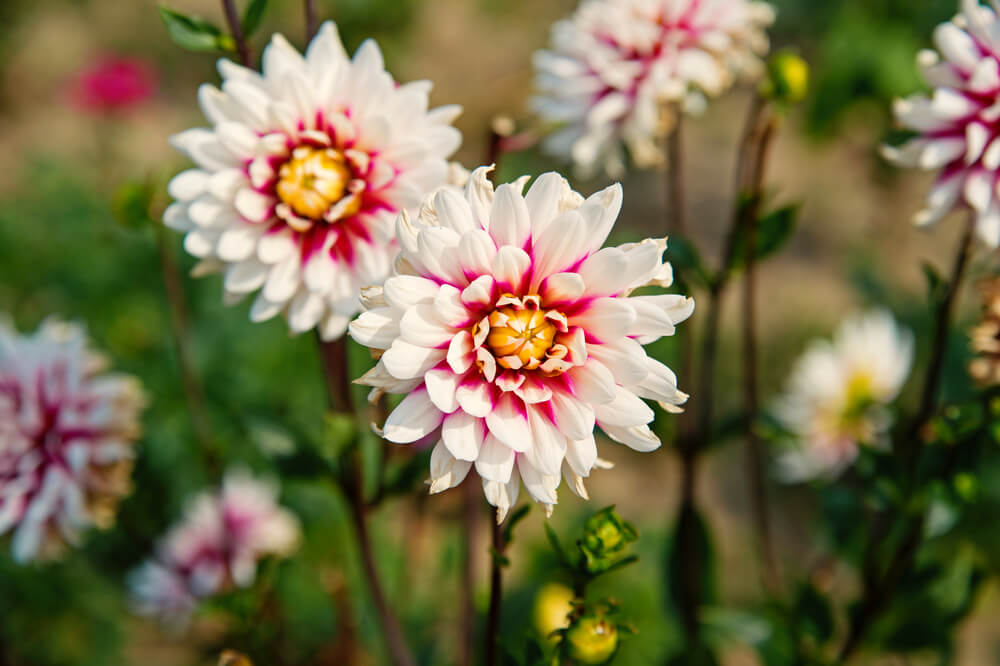
Those who grow their dahlias outdoors can winter them indoors at the end of the growing season. After the frost, cut them back to soil level, then find a dark, dry, and cool place to store them. Note this area cannot freeze, or your tubers may die.
Now, since you have your flowers indoors, what’s the difference? None really, but for the fact you have options. The first is waiting until a Dahlia’s flower is gone. At this point, cut the stalk to the ground and wait. You should see new sprouts soon.
Alternatively, you could “winter” one plant and bring out another pot ready for reawakening. This allows your tubers to gain growing energy. By cycling around on a regular basis, you can have flowers in your house year-round and change them by season.
It’s smart to check all of your plants in dormancy for signs of mold or other issues on a regular basis.
Fit For a Queen
Both Marie Antoinette and Queen Victoria favored Dahlias. As such, they often adorned the court.
Dahlia Needs
Every plant has requirements that improve its health. Besides sunlight, water, and spacing, there are a few other things you can do for your flowers to keep them happy.
- Be supportive. Stake your Dahlias. Large blooms can become heavy. Garden stakes and even a small tomato cage will work (but the garden steaks look nicer indoors).
- Pinch me. Pinching Dahlias encourages the production of more stems. This does delay flowering for about 2 weeks, but you will end up with more buds. When your plant has 4 pairs of leaves, it’s time to pinch it. Cut 3” off the center stem (you should have 3 sets of leaves remaining on the plant).
- Fertilizer: The best fertilizer for Dahlias is one low in nitrogen but high in phosphorus and potassium. Look for 2-4-4 mixes. Apply to your indoor dahlias every 2-3 weeks.
Delight in Dahlias
Besides being the official flower of Seattle and San Francisco, there are hundreds of festivals and celebrations all around the world just for this flower, including
| Event | Where | When |
|---|---|---|
| The New York State Fair Dahlia Show | Central NY | Late Aug. to early Sept. |
| Annual Dazzling Dahlia Festival | Highlands NC | Early Sept. |
| Dahlia Festival | Australia | Mid March |
| Dahlia Fest ’23 | Williamstown NY | Late Sept. |
| Dahlia Festival 2023 | Netherlands | Mid Aug. to Mid Oct |
| Coutances’ Dahlia Festival | Normandy | Month of September | Swan Island Dahlias | Canby, OR | Aug. to end Sept. | 2023 Dahlia Show | Marysville, OH | Early Sept. |
Common Problems with Dahlias
People report specific problems again and again with Dahlias, and wonder about the cause. The main one is that the tuber never produces any flowers. This can happen due to lack of sunlight, being too cold (temps under 60F), or undernourished soil.
Brown Leaves
When your dahlias receive 8 hours or more of light daily, they may brown and dry out. Effectively, they’re sunburned. However, if the leaves wilt by day but look better at night, your dahlia may have wilt disease. Cut off any part of the plant showing signs of illness.
If it’s late in the season, you may have nothing at all to worry over. Your plant is entering dormancy.
Closed Buds
Your Dahlia has buds, but they never open. The main culprit is overwatering or underwatering. Also, check for signs of bugs. For example, tiny holes imply a thrip infestation.
Distorted Flowers
When your Dahlia blossoms look odd and misshapen, most often, you are dealing with insects of disease. Leafhoppers or aster yellows bacteria are likely.
Fuzzy Leaves
Fuzzy leaves are Powdery Mildew. It begins due to high humidity by day, followed by cool nights. Cut off any affected plant parts diligently. If the fuzz is gray, however, it’s gray mold. As with powdery mildew, prune, prune, prune.
Only a Few Blossoms
Perhaps your Dahlia eventually blossoms, but the flowers are few. Cut off the dead flowers. This channels more energy into the plant for a better display. Note that pinching your dahlias early in the season encourages more blooms. Also, make sure you remove dead heads. Other possible reasons include diseases or insects.
Yellow Leaves
Excessive watering or nutrient deficiencies can cause yellowing. Change your watering methods. Move slowly and stop when the soil is moist, not wet. Underwatering can cause yellow leaves, too, but they will be dry and curling. As for nutrients, get a soil test. You need the media at a pH of 6.5.
Now, if the plants have splotchy leaves, that’s likely insects. Most often, it’s aphids or spider mites. They can do a lot of damage very quickly. Use your hose to spray the underside of your leaves. Horticultural oils are also effective. Keep on pruning affected areas.
What’s in a Color?
Every color of dahlia has a specific symbolic meaning. Red dahlias are an expression of passion and romance. Pink dahlias aren’t as intense as red, communicating appreciation and admiration. Yellow blossoms convey joy, friendship, and new beginnings. The white dahlia speaks of spiritual awareness, and the purple ones embody dignity.
You Can Eat Dahlias
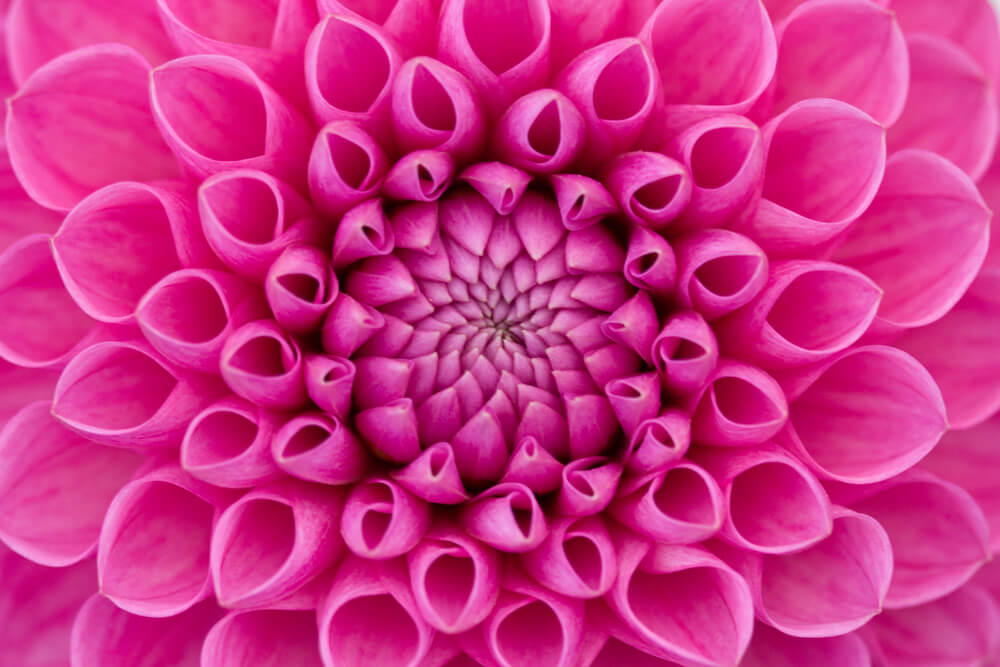
At one time Dahlias were grown for food. They taste a bit like a cross between potatoes, carrots, and celery. They are starchy and mildly sweet. Some cooking ideas include
- Dahlia Quesadilla Packets
- Dahlia Kimchi
- Dahlia Ice Cream
- Tuber bread
- Cooking them yam style
- As tea
- In salads
Dahila Disclosures for Indoor Growing
When you’re looking for a stunning indoor array, you can’t go wrong with Dahlias. There are so many varieties and colors you will never grow tired of growing them. Pick out lovely pots suited to your style with good drainage, along with potting soil, and you’re ready to go. By carefully timing your tuber care, you can produce a year-round display of dahlias, creating a feast for your eyes. By growing dahlias, you’re partaking in an age-old tradition enjoyed by paupers and royalty alike.
[wp-faq-schema title=”Frequently Asked Questions About Dahlia Disclosures for Indoor Growing” accordion=1]

